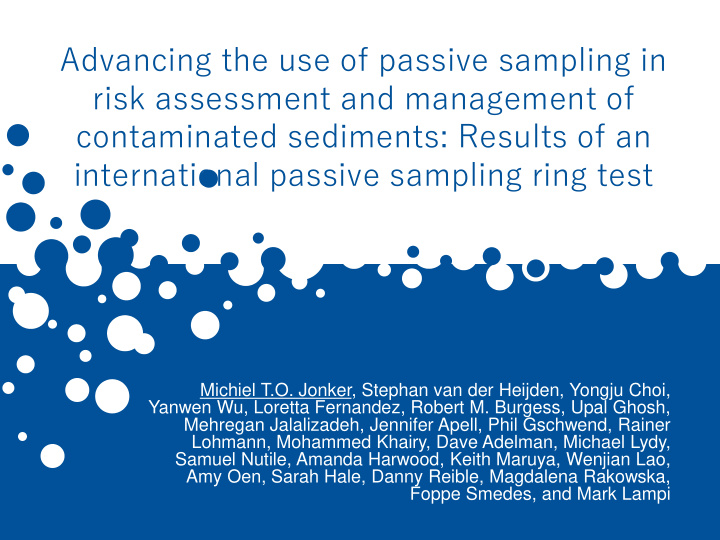



Advancing the use of passive sampling in risk assessment and management of contaminated sediments: Results of an international passive sampling ring test Michiel T.O. Jonker, Stephan van der Heijden, Yongju Choi, Yanwen Wu, Loretta Fernandez, Robert M. Burgess, Upal Ghosh, Mehregan Jalalizadeh, Jennifer Apell, Phil Gschwend, Rainer Lohmann, Mohammed Khairy, Dave Adelman, Michael Lydy, Samuel Nutile, Amanda Harwood, Keith Maruya, Wenjian Lao, Amy Oen, Sarah Hale, Danny Reible, Magdalena Rakowska, Foppe Smedes, and Mark Lampi
Acknowledgments Cefic-LRi; ECO22 project Bruno Hubesch Mark Lampi ILSI-HESI Michelle Embry ECETOC Malyka Galay Burgos Various funding agencies participants
Background (1) • Numerous sediments & soils are contaminated with organic contaminants, such as PAHs & PCBs • Current risk assessment based on total, solvent-extractable concentrations • Not the total, but only the ‘bioavailable’ concentration is available for uptake in organisms and causing effects • Improved risk assessment (less false positives) is possible, based on bioavailable concentrations
Background (2) • Several methods have been developed for measuring bioavailable concentrations • Most attention currently paid to ‘passive sampling’, i.e., using polymer samplers to determine ‘freely dissolved concentrations’ in sediments/soils • Passive sampling is a mature technique in science, but not yet fully accepted in the regulatory community: there is no scientific consensus on which technique to apply (range of methods available) • Need for: • Scientific consensus: comparison study of different methods • Information on robustness (variability/accuracy) • Standardization of method(s)
Objectives • Map the state of the science of passive sampling (performance) in sediments: Quantify intermethod and interlab variability • Investigate how any (unacceptable) variation can be reduced • Recommend standard method(s)
Setup (1) General setup • 11 labs participating in ring test; 1 coordinating lab (UU) • 14 passive sampling formats • 3 different sediments • 25 target compounds
Setup (2) Participants • Established track record in passive sampling with sediments • Netherlands, Norway, Czech Republic, Korea, USA
Setup (3) Passive sampling formats • Polyethylene (PE): 6 suppliers; 2 thicknesses (25 and 50 µm) • Polydimethylsiloxane (PDMS): 5 different SPME fibers (suppliers and coating thicknesses – 10, 30, 100 µm) • Polyoxymethylene (POM): 2 suppliers and 3 thicknesses (17, 55, 77 µm) • Polyacrylate (PAc): 30 µm coated SPME fibers • Silicone rubber (SSP): 100 µm thickness
Setup (4) Compounds • 13 PAHs (3-6 rings) and 12 PCBs (tri- to heptachlorinated) • Range in hydrophobicity, partitioning behavior, freely dissolved concs
Setup (5) Sediments 3 sediments differing in complexity: Spiked sediment ( SP ): high concentrations 1. spiked; low background; sandy; TOC=1.4 2. Field contaminated sediment (Dutch; Biesbosch area; BB ): homogeneous; low concentrations PAHs and PCBs; TOC=4.3 ‘Composed’ sediment ( FD ): 2 field sediments 3. mixed. - French, sandy sediment; low-high PCB levels (no PAHs) - Dutch, clayey sediment; moderate PAH levels (no PCBs); NAPLs (diesel) present; TOC=2.3
Setup (6) Experiments ‘ Own procedure ’: Participants followed their own approach 1. ‘ Standardized procedure ’: Participants followed standard protocols (UU) 2. 3. Standardized procedure, but extracts analyzed by UU ‘ All @ UU ’: all 14 formats applied (standardized) and analyzed by UU 4. 5. Additional tests: - analysis of analytical standard and weighing test (all participants) - solvent extraction and recovery tests, homogeneity test (UU) - Partition coefficients ( K pw ’s) for all compd’s and polymers (UU)
Results (1) 1. Own procedure (State of the science in passive sampling) BB FD SP Chemical-averaged variation range factor (95% percentile / 5% percentile) 29 9 10 All chemicals 9 10 Without PCB-77
Results (2) 1a. Own procedure (Effect of standardizing K pw ’s) BB FD SP Chemical-averaged variation range factor (95% percentile / 5% percentile) 21 10 12 All chemicals 9 10 Without PCB-77
Results (3) 2. Standard procedure (Effect of standardizing protocols & K pw ’s) BB FD SP Chemical-averaged variation range factor (95% percentile / 5% percentile) 9 4 7 All chemicals 5 4 Without PCB-77
Results (4) 3. Standard procedure, analyzed @ UU (Impact of analytical chemistry) BB FD SP Chemical-averaged variation range factor (95% percentile / 5% percentile) 2.4 2.6 2.4
Results (5) Standard analytical solution Averaged variation range factor (95% percentile / 5% percentile) 2.8
Results (6) 4. All @ UU (Intermethod variation) BB FD SP Chemical-averaged variation range factor (95% percentile / 5% percentile) 1.7 1.7 1.6
Summary (BB sediment) Interlab + intermethod 10 10 4 2.4 protocol analytics K pw s 1.6 Intralab / intermethod
Conclusions • Variation in passive sampling results (current practice) is rather (too) large • Important contribution to the variation by analytical chemistry! Identification, integration, calibration • Variation can be significantly reduced by standardizing protocols Standardization: polymer washing procedures, polymer/sediment ratio, sediment/water ratio, way and time of mixing, extraction solvent and procedure • Standardizing K pw ’s does not reduce variation, but is essential for precision of C free • Different polymers yield very similar results: Intermethod variability is small (within a factor of 1.6) • Passive sampling is a robust method - ready for use within regulatory applications, provided that standard protocols are used and analytical chemistry is quality controlled
Recommend
More recommend